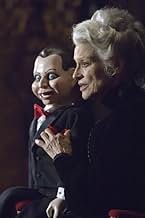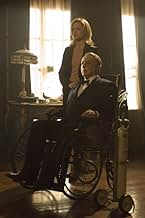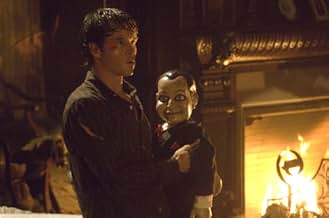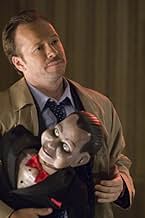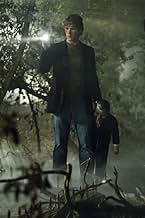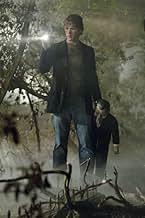Un joven viudo regresa a su ciudad natal para buscar respuestas al asesinato de su esposa, que podría estar relacionado con el fantasma de un ventrílocuo fallecido.Un joven viudo regresa a su ciudad natal para buscar respuestas al asesinato de su esposa, que podría estar relacionado con el fantasma de un ventrílocuo fallecido.Un joven viudo regresa a su ciudad natal para buscar respuestas al asesinato de su esposa, que podría estar relacionado con el fantasma de un ventrílocuo fallecido.
Enn Reitel
- Billy
- (voz)
Fred Tatasciore
- Clown
- (voz)
Austin Majors
- Michael Ashen
- (voz)
- (sin créditos)
Julian Richings
- Bos
- (sin créditos)
Argumento
¿Sabías que…?
- Trivia(at around 1h 10 mins) During the climax, in the storage area with all 101 dolls, you can see Jigsaw's doll from the "Saw" films sitting on the floor, and Edgar Bergen's doll Charlie McCarthy on one of the shelves. The doll that Detective Lipton throws over his shoulder in this scene is a replica of ventriloquist Jimmy Nelson's doll, Danny O'Day.
- ErroresJamie states that in his hometown, receiving a ventriloquist dummy out of nowhere is a bad omen. If so then why didn't he get rid of it when it arrived at his doorstep?
- Citas
Children's Rhyme: Beware the stare of Mary Shaw / She had no children only dolls / And if you see her in your dreams / Be sure to never ever scream.
- Créditos curiososThe 1930s Universal Pictures logo is used in the opening credits.
- Versiones alternativasUnrated DVD contains the following extended shots which were omitted from the "R" rated version.
- Mary Shaw has a creepy, disgusting, long tongue.
- A gorier death for Henry, as Mary Shaw is shown eating Henry's tongue and saying "I now have your voice, Henry."
- The tongue comes out and licks Jamie after the clown admits the "secret" to him about his wife.
- ConexionesFeatured in Oh, We Review!: Dead Silence (2012)
- Bandas sonorasLet It Go
Written by Bob Mair, Dino Soldo
Performed by Bob Mair, Dino Soldo
Courtesy of Black Toast Music
Opinión destacada
When, in 2004, James Wan and Leigh Whannell ran, with just over $1 million and in just under a month, Saw, perhaps they did not imagine that they were performing what would be one of the best and most well- successful thrillers of a whole decade. The commercial success allowed young people to produce, with a much larger budget, sequences that, more technically sophisticated (mainly the second and third parts, directed by Darren Lynn Bousman) were absolute blockbusters, projecting the Jigsaw character (played brilliantly by Tobin Bell) to the post of first great horror film villain of this millennium.
The duo James and Leigh were filling their pockets with cash and becoming more and more powerful in Hollywood, gaining creative and financial freedom for what would be their next project: Dead Silence (as the sum of the budgets of the first three films in the Death Games franchise was approximately $17 and a half million, the resources available to the duo in their new venture exceeded $20 million). For all that, great expectations were created around the release of Dead Silence. The original script was developed by James Wan and Leigh Whannell themselves, and according to the authors' definition, it is closer to the classic horror, and would even be inspired by the productions of the legendary Hammer (English producer responsible for the first color adaptations of Dracula and Frankenstein). Therefore, the plot would develop much more atmosphere and explore violence less than Death Games.
The story is sure to make many remember the endless saga of Child's Play, Chucky. To start the plot, an interesting and convenient explanation of the origin of the word "ventriloquist" and the legends about it is presented, which makes the story more intelligible. Introductions made, we are led to the scene in which Jamie (Ryan Kwanten) and Lisa Ashen (Laura Regan), happily married and living far from their birthplace, Raven's Fair, receive a strange ventriloquist puppet, which reminds them of ventriloquist Mary Shaw, who was murdered in the city for being suspected of kidnapping and killing children. As expected, after something strange happens, Jamie leaves, leaving his wife at home alone. And to his surprise (not ours, of course), he finds his wife dead in his bed, her tongue torn out. And, of course, Jamie is suspect number one. To try to prove his innocence, Jamie returns to his hometown, even though he is banned by court orders, willing to face the legend and put an end to the ghost of Mary Shaw.
Dead Silence is perhaps the most significant film for understanding why James Wan's artistic vision has made him the most popular name in horror in the 21st century. The filmmaker, in addition to presenting an expert and skillful mastery of the camera, able to involve the viewer in his accelerated rhythmic and instigating mystery, while also valuing the atmospheric construction of the ambiance for the fright - which may or may not come and then he's one of the best at handling the jump scare feature - on top of that, he has a broad repertoire in the genre, used very well to his advantage to coordinate the haunting effect of his stories making them seem bigger than they really are. Wan and Whannell work with super established clichés in horror, especially in terms of plot. There is a pre-plot formula used in this regard, starting with as little information as possible at the base and supporting the plot hole on a growing mystery of figuring out what the main threat is. Through this, Wan manipulates the very lines of his text, essentially superfluous as it is a beaten string of elements of the genre that everyone knows and he has a lot of repertoire, but which are very well directed in stages in the film to base their main villain on an iconography visual that is the mainstay for the effect of distorting the supposed complexity of the story.
The script, however, suffers from some structural problems and creates some unlikely situations, such as the "avenger" husband, who seems more interested in unraveling the mystery of the strange puppet, than suffering the violent death of his recently murdered wife or the policeman who pursues a murder suspect with no real commitment to arresting him. The little credibility of the characters and their motivations, as said, are not noticeable when we are involved in this atmosphere, conducted in the sequencing of scenes that may or may not cause fright, being those that yield this compensation for the fear created by being frightened, working because they are really very well-orchestrated, hidden to be released at the right moment when our psychological kind of gave up on them and the ones that don't, being an integral part of this process of momentary and atmospheric involvement that binds us to the film. This is because Wan's manipulation always keeps us very comfortable in terms of information that is given to us, where the director provides it on a platter, through flashbacks well fitted in the outline of the narrative, which makes us think that we are with him in the resolution of the mystery which invited us at first to participate, but actually makes it one step ahead, or at least provides a hiding place for a great piece of information, used in the climax as a twist.
This big turnaround is built more on the effect of quickly tying everything together in the edit by reminiscing about scenes than on the surprise, the revelation itself and how it fits into the storyline. It doesn't matter whether or not it makes logical sense or not, the Dead Silence doesn't do the slightest thing, but it closes the line to what he prioritizes as terror, which is to say what is the threat. In this way, the public ignores any breach of verisimilitude and concentrates on the ultimate confirmation of Mary Shaw's dangerousness, which he sustained the atmosphere to emphasize her iconography. The icing on the cake was not proving that the story was smarter than we were invited to immerse ourselves in it - even if that is a bit of the feeling when we didn't notice the connections beforehand - but rather that we were afraid while it was. Being told. The lack of verisimilitude only fits this, as the supernatural and the unknown, which were the minimal basis for investing in the mystery, are also confirmed. Apart from Charlie Clouser's soundtrack, which even derived from Mortal Games, is very good.
The great asset of "Dead Silence" is, without a doubt, the look. What we see on the screen is a real candy for our eyes. Everything works: the photography is chilling, the settings are extremely luxurious and the atmosphere old-fashioned. The kills are stylish, the makeup is really well done, and the special effects are great. From what our eyes see, the script could be a little more generous with our intellect, especially when it comes to the Wan/Whannel duo, much more was expected. The story, despite its immensely inspired points, is by no means innovative. Just the fact that you, when watching a movie, immediately remember another, already shows that the idea has already been used, and well explored. Any horror movie that involves puppets will take us back to "Toy Killer", which marked horror fans in the 90s. But that is not the greatest resemblance. The number of dolls, 101 in all, is unnecessary (here, 101 dolls are practically the same, and they do absolutely nothing). Despite the relative passivity of the puppets, the main one, Billy (Mary Shaw's great partner in her shows), gives the viewer good scares. But the main scene of the film, apart from the ending (which I'll tell you below), is when one of the duo's performances is shown in a flashback. It's from her that we can be sure that Mary Shaw's stories are, yes, true, and that her favorite doll isn't exactly just a doll.
The film becomes technically interesting due to the well-known combination of James Wan and the atmosphere of a script that seeks the right light for the final immersion. The quality and guarantee of a somber presentation of scenarios proposed as belonging to this category is the bastion used here to finish the great tale about Mary Shaw with style and without burning too much the balance line between the imaginary and the real revelations that for a short period of discovery orbit the main character. Like "Saw", presents an ending that leaves any spectator awestruck (of course, not in the same magnitude as "Saw" does), and this ends up being the highest point of the plot. Despite the script's clichés and minor confusions, this is a great entertainment option for horror fans. Just don't forget one thing: "Never, ever scream!"
The duo James and Leigh were filling their pockets with cash and becoming more and more powerful in Hollywood, gaining creative and financial freedom for what would be their next project: Dead Silence (as the sum of the budgets of the first three films in the Death Games franchise was approximately $17 and a half million, the resources available to the duo in their new venture exceeded $20 million). For all that, great expectations were created around the release of Dead Silence. The original script was developed by James Wan and Leigh Whannell themselves, and according to the authors' definition, it is closer to the classic horror, and would even be inspired by the productions of the legendary Hammer (English producer responsible for the first color adaptations of Dracula and Frankenstein). Therefore, the plot would develop much more atmosphere and explore violence less than Death Games.
The story is sure to make many remember the endless saga of Child's Play, Chucky. To start the plot, an interesting and convenient explanation of the origin of the word "ventriloquist" and the legends about it is presented, which makes the story more intelligible. Introductions made, we are led to the scene in which Jamie (Ryan Kwanten) and Lisa Ashen (Laura Regan), happily married and living far from their birthplace, Raven's Fair, receive a strange ventriloquist puppet, which reminds them of ventriloquist Mary Shaw, who was murdered in the city for being suspected of kidnapping and killing children. As expected, after something strange happens, Jamie leaves, leaving his wife at home alone. And to his surprise (not ours, of course), he finds his wife dead in his bed, her tongue torn out. And, of course, Jamie is suspect number one. To try to prove his innocence, Jamie returns to his hometown, even though he is banned by court orders, willing to face the legend and put an end to the ghost of Mary Shaw.
Dead Silence is perhaps the most significant film for understanding why James Wan's artistic vision has made him the most popular name in horror in the 21st century. The filmmaker, in addition to presenting an expert and skillful mastery of the camera, able to involve the viewer in his accelerated rhythmic and instigating mystery, while also valuing the atmospheric construction of the ambiance for the fright - which may or may not come and then he's one of the best at handling the jump scare feature - on top of that, he has a broad repertoire in the genre, used very well to his advantage to coordinate the haunting effect of his stories making them seem bigger than they really are. Wan and Whannell work with super established clichés in horror, especially in terms of plot. There is a pre-plot formula used in this regard, starting with as little information as possible at the base and supporting the plot hole on a growing mystery of figuring out what the main threat is. Through this, Wan manipulates the very lines of his text, essentially superfluous as it is a beaten string of elements of the genre that everyone knows and he has a lot of repertoire, but which are very well directed in stages in the film to base their main villain on an iconography visual that is the mainstay for the effect of distorting the supposed complexity of the story.
The script, however, suffers from some structural problems and creates some unlikely situations, such as the "avenger" husband, who seems more interested in unraveling the mystery of the strange puppet, than suffering the violent death of his recently murdered wife or the policeman who pursues a murder suspect with no real commitment to arresting him. The little credibility of the characters and their motivations, as said, are not noticeable when we are involved in this atmosphere, conducted in the sequencing of scenes that may or may not cause fright, being those that yield this compensation for the fear created by being frightened, working because they are really very well-orchestrated, hidden to be released at the right moment when our psychological kind of gave up on them and the ones that don't, being an integral part of this process of momentary and atmospheric involvement that binds us to the film. This is because Wan's manipulation always keeps us very comfortable in terms of information that is given to us, where the director provides it on a platter, through flashbacks well fitted in the outline of the narrative, which makes us think that we are with him in the resolution of the mystery which invited us at first to participate, but actually makes it one step ahead, or at least provides a hiding place for a great piece of information, used in the climax as a twist.
This big turnaround is built more on the effect of quickly tying everything together in the edit by reminiscing about scenes than on the surprise, the revelation itself and how it fits into the storyline. It doesn't matter whether or not it makes logical sense or not, the Dead Silence doesn't do the slightest thing, but it closes the line to what he prioritizes as terror, which is to say what is the threat. In this way, the public ignores any breach of verisimilitude and concentrates on the ultimate confirmation of Mary Shaw's dangerousness, which he sustained the atmosphere to emphasize her iconography. The icing on the cake was not proving that the story was smarter than we were invited to immerse ourselves in it - even if that is a bit of the feeling when we didn't notice the connections beforehand - but rather that we were afraid while it was. Being told. The lack of verisimilitude only fits this, as the supernatural and the unknown, which were the minimal basis for investing in the mystery, are also confirmed. Apart from Charlie Clouser's soundtrack, which even derived from Mortal Games, is very good.
The great asset of "Dead Silence" is, without a doubt, the look. What we see on the screen is a real candy for our eyes. Everything works: the photography is chilling, the settings are extremely luxurious and the atmosphere old-fashioned. The kills are stylish, the makeup is really well done, and the special effects are great. From what our eyes see, the script could be a little more generous with our intellect, especially when it comes to the Wan/Whannel duo, much more was expected. The story, despite its immensely inspired points, is by no means innovative. Just the fact that you, when watching a movie, immediately remember another, already shows that the idea has already been used, and well explored. Any horror movie that involves puppets will take us back to "Toy Killer", which marked horror fans in the 90s. But that is not the greatest resemblance. The number of dolls, 101 in all, is unnecessary (here, 101 dolls are practically the same, and they do absolutely nothing). Despite the relative passivity of the puppets, the main one, Billy (Mary Shaw's great partner in her shows), gives the viewer good scares. But the main scene of the film, apart from the ending (which I'll tell you below), is when one of the duo's performances is shown in a flashback. It's from her that we can be sure that Mary Shaw's stories are, yes, true, and that her favorite doll isn't exactly just a doll.
The film becomes technically interesting due to the well-known combination of James Wan and the atmosphere of a script that seeks the right light for the final immersion. The quality and guarantee of a somber presentation of scenarios proposed as belonging to this category is the bastion used here to finish the great tale about Mary Shaw with style and without burning too much the balance line between the imaginary and the real revelations that for a short period of discovery orbit the main character. Like "Saw", presents an ending that leaves any spectator awestruck (of course, not in the same magnitude as "Saw" does), and this ends up being the highest point of the plot. Despite the script's clichés and minor confusions, this is a great entertainment option for horror fans. Just don't forget one thing: "Never, ever scream!"
- fernandoschiavi
- 25 dic 2021
- Enlace permanente
Selecciones populares
Inicia sesión para calificar y agrega a la lista de videos para obtener recomendaciones personalizadas
Detalles
- Fecha de lanzamiento
- Países de origen
- Sitios oficiales
- Idioma
- También se conoce como
- Dead Silence
- Locaciones de filmación
- Productoras
- Ver más créditos de la compañía en IMDbPro
Taquilla
- Presupuesto
- USD 20,000,000 (estimado)
- Total en EE. UU. y Canadá
- USD 16,809,076
- Fin de semana de estreno en EE. UU. y Canadá
- USD 7,842,725
- 18 mar 2007
- Total a nivel mundial
- USD 22,382,047
- Tiempo de ejecución1 hora 29 minutos
- Color
- Mezcla de sonido
- Relación de aspecto
- 2.39 : 1
Contribuir a esta página
Sugiere una edición o agrega el contenido que falta

Principales brechas de datos
What is the streaming release date of El títere (2007) in Australia?
Responda







